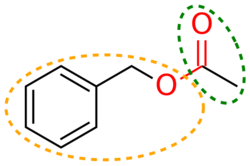Chemistry:Moiety

In organic chemistry, a moiety (/ˈmɔɪəti/ MOY-ə-tee) is a part of a molecule[1][2] that is given a name because it is identified as a part of other molecules as well.
Typically, the term is used to describe the larger and characteristic parts of organic molecules, and it should not be used to describe or name smaller functional groups [1][2] of atoms that chemically react in similar ways in most molecules that contain them.[3] Occasionally, a moiety may contain smaller moieties and functional groups.[citation needed]
A moiety that acts as a branch extending from the backbone of a hydrocarbon molecule is called a substituent or side chain, which typically can be removed from the molecule and substituted with others.
The term is also used in pharmacology, where an active moiety is the part of an atom responsible for the physiological or pharmacological action of a drug.
Active moiety
In pharmacology, an active moiety is the part of a molecule or ion – excluding appended inactive portions – that is responsible for the physiological or pharmacological action of a drug substance. Inactive appended portions of the drug substance may include either the alcohol or acid moiety of an ester, a salt (including a salt with hydrogen or coordination bonds), or other noncovalent derivative (such as a complex, chelate, or clathrate).[4][5] The parent drug may itself be an inactive prodrug and only after the active moiety is released from the parent in free form does it become active.
See also
References
- ↑ 1.0 1.1 IUPAC, Compendium of Chemical Terminology, 2nd ed. (the "Gold Book") (1997). Online corrected version: (2006–) "moiety". doi:10.1351/goldbook.M03968
- ↑ 2.0 2.1 "Illustrated Glossary of Organic Chemistry - Moiety". http://web.chem.ucla.edu/~harding/IGOC/M/moiety.html.
- ↑ IUPAC, Compendium of Chemical Terminology, 2nd ed. (the "Gold Book") (1997). Online corrected version: (2006–) "functional group". doi:10.1351/goldbook.F02555
- ↑ "CFR – Code of Federal Regulations Title 21". United States Food and Drug Administration. 1 April 2018. https://www.accessdata.fda.gov/scripts/cdrh/cfdocs/cfcfr/cfrsearch.cfm?fr=314.3.
- ↑ "Electronic Code of Federal Regulations Title 21: Food and Drugs § 314.3". United States Government Publishing Office. 22 January 2019. https://www.ecfr.gov/cgi-bin/text-idx?SID=32b6a1fbd1a07e487c95cb72b5c72d13&mc=true&node=se21.5.314_13&rgn=div8. "Active moiety is the molecule or ion, excluding those appended portions of the molecule that cause the drug to be an ester, salt (including a salt with hydrogen or coordination bonds), or other noncovalent derivative (such as a complex, chelate, or clathrate) of the molecule, responsible for the physiological or pharmacological action of the drug substance."

